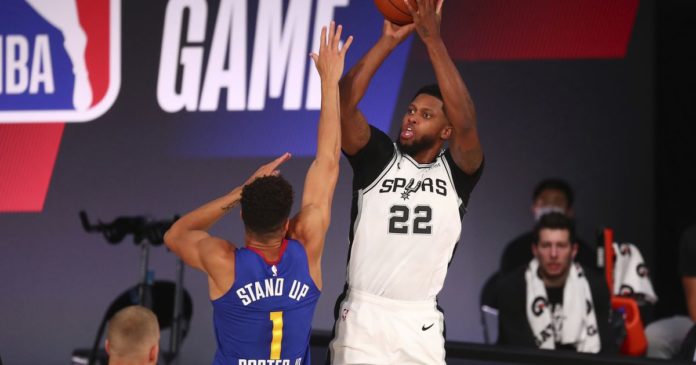
What will Rudy Gay bring to the Utah Jazz?
Generally, with players who have been in the NBA for 15 years, we have a pretty good mental image of who they are as a player. The Jazz knew exactly what they were getting with Joe Johnson, for example. The other 15-year veterans in the NBA last season were Kyle Lowry, Rajon Rondo, Paul Millsap, and J.J. Redick — three of those guys have essentially had pretty similar roles over their entire careers, and Millsap’s perimeter-oriented revolution happened a decade ago, now.
But Gay is a little bit different. When he signed in San Antonio four years ago, he did so with two goals in mind: win a championship, and show off an expanded skillset, proving that he was more than just a scorer. And over the course of his four seasons with the Spurs, he played in a variety of different roles, and adapted his game to his aging as well. As a result, evaluating Gay is more of a moving target than those other veterans.
We’ll try to nail that target down anyway. After watching hours of film, talking to Spurs fans and writers, and digging into all the stats, here’s what I make of Rudy Gay.
A wacky shot chart
I think the first thing to do is to take a look at Gay’s shot chart. It’s a little unusual!
NBA.com shot chart for Rudy Gay in the 2020-21 season.
So what do we notice about the chart?
1. He’s actually a pretty abysmal corner 3-point shooter, a trend that was true the season previous, too. 22% from that left corner is ugly, and that 35% from the right one is below average.
2. But he makes up for it by being an excellent 3-point shooter from the wings. Look for Quin Snyder’s offense to station him there more, which could mean more of, say, Royce O’Neale, Joe Ingles, or even Jared Butler in the corner instead.
3. He takes a lot of shots from the midrange compared to the average NBA wing in 2021, especially in the 8-16 feet zones. He’s relatively average at making them.
4. Near the rim, he was a below-average finisher, despite his good size.
Gay has evolved as a scorer over the last four years, doubling the number of attempts he takes from beyond the arc. But he certainly still has the ability to drive, stop short, and score in the midrange from pull-up looks, fadeaway attempts, or push shots — if you’re mostly familiar with the Jazz, think of a bigger version of Jordan Clarkson. His trademark move is probably getting his body into a player, then knocking down the midrange shot with the space he just created.
Just like Clarkson, he takes some really bad shots early in the shot clock, to the disappointment of San Antonio fans. It’s going to be interesting to see those guys play together, actually — can they utilize each other’s gravity in any way? Or is it going to be a my-turn, your-turn offense from the Jazz’s bench this season?
Regardless, Gay can still score at near-league average efficiencies. He averaged 19 points per 36 minutes on 53.2% true shooting last season. In his Memphis prime, he averaged 18 points per 36 minutes on 52% true shooting. The shot chart has changed, but the efficiency is basically the same.
The cool thing about Gay offensively is his versatility. Yes, he can run a pick and roll — usually, he’s going to be looking to score himself or pass to a wing from it, though; he’s not a lob passer right now. He’s good in transition. He’s good as a spot-up shooter on the wings. He can break people down in isolation. He can post people up. He does all of this at about league-average efficiency, so he’s kind of a Swiss Army knife in that respect: maybe not the knife you want to make dinner with, but really handy to have around nonetheless.
And in San Antonio, he even played a lot of small-ball five when injuries struck, making him a screener. Generally, he’d pick-and-pop, and got some good looks from deep as a result. Maybe that’s a potential solution for the my-turn, your-turn concern: have Gay screen for Clarkson with an empty paint, and let either take advantage of the space afforded.
Passing and rebounding
Gay averaged 1.4 assists per game last season, which I think is pretty representative — it’s about the same passes per possession as Bojan Bogdanovic had. I think that’s a pretty good comparison for Gay’s level of playmaking: just like Bogdanovic, Gay is playing pick and roll, attacking closeouts, and playing in isolation with the intention of scoring first. Just like Bogdanovic, he’s very capable of moving the ball if he gets doubled, or swinging it along the perimeter if need be.
Gay turned it over slightly less than Bogdanovic did last season, though. In general, rather than taking that extra dribble that Bogdanovic does to get deeper into the paint for a layup — a dribble that could get stripped — Gay is just gonna pull up and take the midrange shot. That’s a risk/reward decision that means Bogdanovic gets more efficient baskets, but at the cost of some turnovers.
But my goodness, he’s a better rebounder than Bogdanovic. In fact, I think he’ll be the Jazz’s best wing rebounder in recent memory, even better than the prolific O’Neale was last season. He’s just good at the basics: realizing where the play is going to happen, getting there early to box out, and then skying for the rebound, even in heavy traffic. Like this:
I think that’s shown in the rebounding stats, too. Here’s how Gay stacks up with the rest of the Jazz in rebounds per minute last season:
Now, it’s worth noting that his rebounding has declined for the last two seasons, and it’s likely that he’s not as bouncy as he was two years ago. Further decline is likely. But even when he does, he’ll still be an asset there.
How good is he on defense?
Okay, this is the section you’re here for. You may have even scrolled directly to this section. That’s okay, we won’t judge. You watched the Jazz get torn to shreds in last year’s playoffs on the defensive end of the floor, and you’re wondering: will Gay help?
Essentially, the short answer is this: he’s going to help in some ways, and not in others. In particular, he’s a good but not great one-on-one perimeter defender right now. The man is 34, and has lost some lateral movement. He is not a stopper, but a very useful defensive cog. He is actually quite good at team defense, and especially help defense. This figures to help the Jazz’s bench defend much better than it did last season — he’s a big upgrade over Georges Niang.
Gay can stick with the good athletes of the NBA, but probably not the great ones. So, for example, here’s him on Caris LeVert — Levert thinks he can take Gay just with a little shoulder shimmy and some speed, and it’s not going to work.
On the other hand, against the elite ballhandling types, he’s going to struggle. The Warriors actually pick him out of the Spurs’ lineup here for Steph Curry to attack, and Curry gets past him.
Against the Jazz, I don’t think teams are going to pick Gay to attack. He’ll likely share most of his minutes with Clarkson, who is a far worse defender. If not, I’d rather attack Bogdanovic, Ingles, Mike Conley or Donovan Mitchell, depending on who the star ballhandler is. And his Synergy numbers last season against isolations (allowing 0.70 points per possession) and pick and rolls (0.80 PPP) were terrific, but he falls well short of being a stopper, and Spurs fans (comparing him to the younger and quicker Devin Vassell) often complained about his lack of impact outside.
The Spurs had him be pretty aggressive on helping from drives on the perimeter. On one hand, that takes advantage of his skills at timing strips and blocks in helping, doing stuff like this.
On the other hand, a better guard recognizes Gay’s help there, and just kicks it out to the open three. Maybe that’s why Gay gave up an above-average number of points per possession (1.04 PPP) on spot-up opportunities, despite his good length.
I’ll be extremely curious to what extent Snyder gives Gay the freedom to roam, to dig in, and to help in general. The Jazz’s regular season defense has been built on funneling drivers to Rudy Gobert, while staying home on shooters, right? But A) Gay will probably play mostly bench minutes frequently not with Gobert, and B) that approach has led to some disappointing defensive results two playoffs in a row now, as the Jazz’s perimeter defenders can’t keep anyone in front. Will Snyder choose to help more this year? If so, Gay is a logical candidate to help muck things up.
Finally, I like what Gay can do inside. This is a rare missed block-out by Gay — he actually verbally recognizes his mistake during the play, which I love — but he’s able to recover and get the block on the ensuing putback chance.
The Jazz didn’t have wings who were making that play last season. O’Neale is too small, and Ingles, Bogdanovic, and Niang aren’t as long or bouncy. Gay can do that, and that’s an added element. Overall, the Spurs were significantly better defensively with Gay on the floor than off.
I think the statistics that show him as an elite defender are optimistic, and the Spurs fans who wanted him off the court were pessimistic; as usual, the truth is in between. I think the video shows that he’s an above-average defender overall, and certainly will be a defensive improvement over some of his teammates with the Jazz.
And heck, that moderate approach should probably define your overall expectations for him also. If you consider Gay good value for the $6 million per year contract he’s getting, and a good pickup by the Jazz, you’re probably going to be relatively happy. If you think he drastically reduces the weaknesses of the team, you’re probably going to be disappointed. Gay is a useful piece, not a game-changing addition.








